PAGE 36 – APRIL 2005
3 MARVELOUS MICROS
+ 3 ISLAND RAILROADS
FUN IN SEXTUPLICATE!
MICRO 1: A CLASSIC, RYELANDS LANE
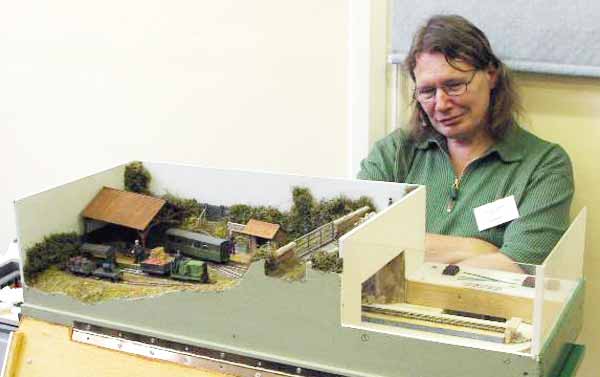
Patriarch of the Pint-sized Platform Chris Krupa, from Cambridge, England, displayed one of his classic micro layouts at the first exhibition sponsored by the recently-founded March & District (Cambridgeshire) Model Railway Club. For those who haven’t previously seen it, Ryelands Lane is presented here as an early and outstandng example of a micro layout.
“The layout is 09, that is to say it is built to 7mm scale (1/43.5) on 9mm gauge track,” Chris explains. “This scales out to fifteen inches [gauge] give or take a bit, and the layout represents a small branch of the main Kendalls Light Railway which is the line built to serve my imaginary Kendalls Estate.
“The station itself is situated in a small valley through which runs the lane which gives the station its name. Access for passengers is via set of steps from the lane above whilst goods and other traffic can come to the (unmodelled) end of the station under the roof.”
The layout measures 83×43 cm (33×17 in). “Ryelands Lane is my first attempt at 09,” Chris continues. “The track plan is adapted from various published ideas which offer the use of a sector plate to take the place of half of a run round. In this instance the working sector plate also provides access to the siding at the front, cutting down the overall size of the layout still further.
“Ryelands Lane is designed for complete portability so the transformer is built in, only requiring to be plugged in to the mains [wall outlet]. Likewise, the stand on which the layout is exhibited is part of the structure with removable parts being stored in the sector plate area when in transit. All the necessary nuts, bolts, cables and test equipment together with the hand held controller and other paraphernalia can also be carried within the layout box. The only other thing which is vital for exhibitions is the separate stock box.
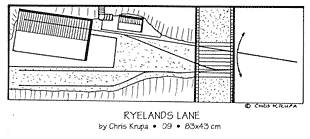
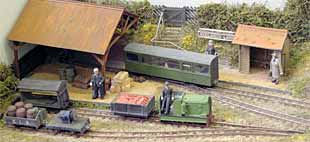
“Operation consists of bringing trains into the station, running round and sorting stock into the appropriate places for return. I imagine there to be other sidings (not modelled) on the far side of the bridge so sometimes the locomotive will depart or arrive with the odd wagon destined for points immediately off stage. During exhibitions, I point out the poster which is displayed on the end of the station building. This advertises a gymkhana [horse show] in a nearby field so there are lots of passenger trains today bringing spectators to watch the fun. There’s a small fair [carnival] too, so the railway has put on extra trains to cope with the traffic.” (Photos by Emrys Hopkins)
MICRO 2: FOR OPERATION, PATAGONIA YARD

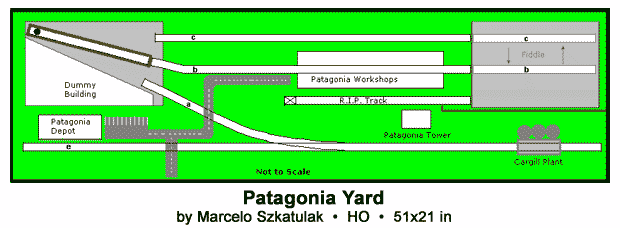
Marcelo Szkatulak, who is from Argentina but lives in Toledo, Spain, is a fan of U.S. railroading and has modeled a bit of his favorite road, the Espee (Southern Pacific). Fittingly, he built a freelanced version of an SP yard in Patagonia, Arizona — “Patagonia” being also the name of a region in southern Argentina!
Although this plan is larger than four square feet, it displays a “micro mind-set” and is an adaptation of a shoebox plan by François Fontana, Cycles le Berlan using both a sector plate and a transfer table. Marcelo is scratchbuilding virtually all the scenery. He also has created an operating method that can be used successfully on many small layouts.
“I like to operate my railroads with big trains like the real lines do,” Marcelo explains, “but this is a small railroad (it´s only a yard!), and for this reason my big locomotives and 50 foot cars are waiting in their boxes for a better opportunity.
“The main reason for my railroad is an interchange between the Cargill Plant, the Patagonia Depot and sending the cars to the ‘Route’ track called ‘c‘ in the plan, returning to Patagonia Depot or Cargill. I have several 40 foot cars (boxcars, tanks, covered hoppers, gondolas, etc.) and little shunters to manage my operating sessions. I have a Car Card for each car in the layout (so far I have tested it running eight cars at one time), and I can work with two little locomotives, a GE 44-tonner and a GM SW-1500.
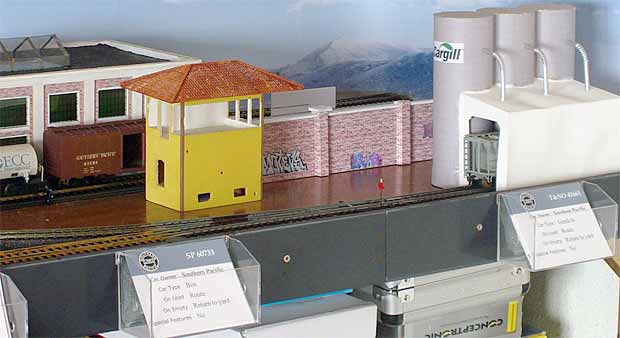
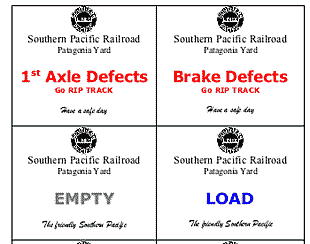 “Each Car Card [in pockets at the front of the layout] reports the car number, car owner´s name, car type, what movement should be made if the car is loaded or empty, and any special instructions — some cars cannot be ‘bumped’ for example, and cabooses need go to to a ‘caboose track’ (an exception to the RIP track for this kind of car).
“Each Car Card [in pockets at the front of the layout] reports the car number, car owner´s name, car type, what movement should be made if the car is loaded or empty, and any special instructions — some cars cannot be ‘bumped’ for example, and cabooses need go to to a ‘caboose track’ (an exception to the RIP track for this kind of car).
“I have a lot of Movement Cards [at right] that tell me what movement to make for a selected car. The cars can be in Patagonia Depot, in the RIP track or in the ‘”c” line (the “Route line”). In each movement card there are messages like Empty, Load, or (the best of them) in red COUPLER DEFECTS Go RIP TRACK or other ‘troubles’ like this.
“When I select a car, I take a Movement Card. After the movement of the car both cards go to the back of the box. The Movement Cards can also be shuffled. When the RIP track is full (it only holds two cars) I generate a special movement to take one of the cars out using a Movement Card in the usual way.
“Friends have asked me why I don’t use a software program to generate movements. But I work with computers all day (I´m a technician) and when I am with my hobby, I don´t want to see a computer!”
MICRO 3: A NEW SHOEBOX, BENEATH THE SURFACE
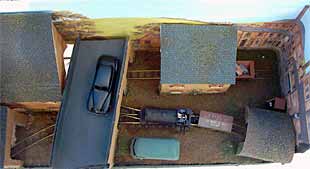
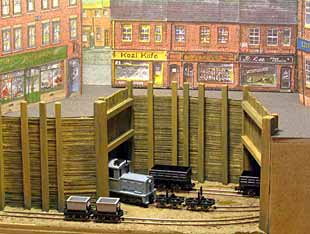
Hans van der Linden, from Eindhoven in The Netherlands, was inspired by this site to try building a shoebox layout — but he wanted to design a “different” track plan. The result: an original plan and a very attractive small layout, which Hans’s friends have dubbed Beneath the Surface.
Hans describes his creation: “The scene depicts a tunnel construction site in a small city, dominated by a large pit with tracks entering two tunnels, one on either side of the layout. Everything above street level (the backgrounds and the houses in front of them, which were all cut from ready-made background scenes) can be lifted off the top of the layout, and folded up into a package less than a centimeter thick, with the same dimensions as the layout’s footprint (33 x 18 cm).
“Hidden in each tunnel entrance is a sector table that gives access to the tracks entering the tunnel, and to a third hidden track at the back. There is an additional track at the front, which emerges from the tunnel at the right and ends at the left. The sector tables extend beyond the layout’s edges when in use, but stay within the 33 x 18 cm footprint when folded up.
“By ‘cheating’ like this with the folding background and sector tables, the layout stays within the 33 x 18 x 12 cm format during transport, but looks much larger when in use.” The two photos below, taken from directly above the layout, show the two sector tables in use (right) and folded up for travel (left).
The layout is built in 009 scale (4mm to the foot, running on 9mm gauge), and more photos are displayed on the web site of the 009 Society’s “Dutch Group” (enter and click on “Project”).
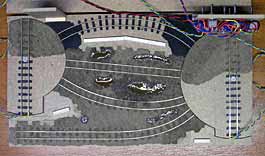
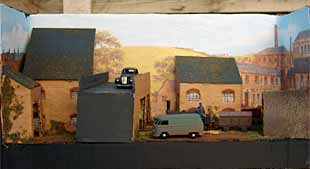
ISLAND 1: RETURN TO LUMMERLAND
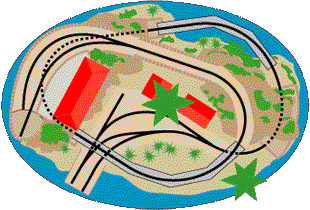
Lummerland is an ellipsoidal O9/On15 layout which depicts a fictional island originally created in a well-known German children’s book, Jim Button and Luke the Engine Driver by Michael Ende. Helmut Heinert, who lives in Germany, built the layout and has exhibited it both on the continent and in England.
Helmut has made significant progress in construction since we last visited Lummerland in Issue #7 of the Small Layout Scrapbook. So here ‘s a group of recent photographs of this much-traveled and very unusual display. There’s a lot more information about the layout available on Helmut’s web site. (Photos by Peter Hoehn)
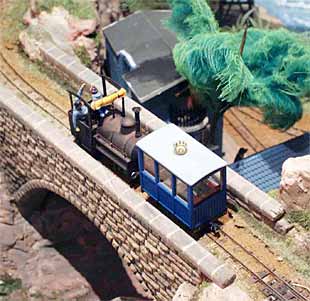
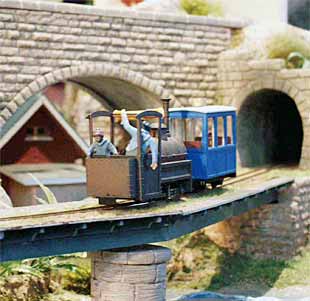
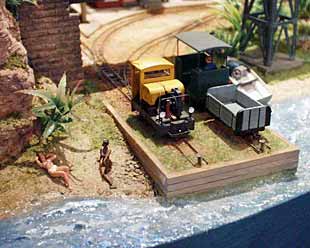
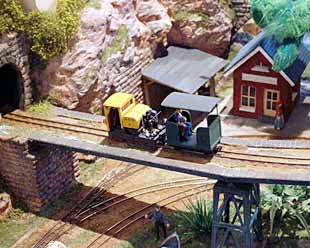
ISLAND 2: ADVENTURES ON THE ISLAND OF MARABUNTA
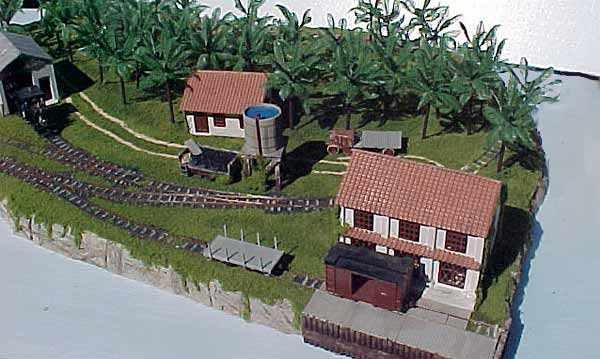
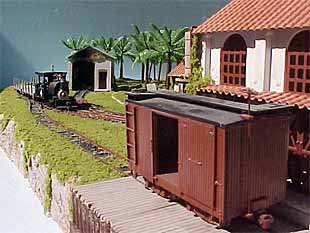 Stumpy Stone, from Martin’s Ferry, Ohio, built Marabunta Island in On30 scale on extruded polystyrene foam measuring 42×27 inches. The business of this island railroad is to help harvest the fruit of the “Venadas” trees for use in the island’s main product, a moonshine called Marabunta Juice. It’s shipped out from the quay after being hauled in from the woods by rail.
Stumpy Stone, from Martin’s Ferry, Ohio, built Marabunta Island in On30 scale on extruded polystyrene foam measuring 42×27 inches. The business of this island railroad is to help harvest the fruit of the “Venadas” trees for use in the island’s main product, a moonshine called Marabunta Juice. It’s shipped out from the quay after being hauled in from the woods by rail.
Stumpy reports, “Structures are kitbashed Plasticville, trees are Sugarcraft cake decorating trees, and the two trucks are cut down K-Line vehicles. The water tower and coal dock are scratchbuilt. Trains are Bachmann locos, Chivers cars, and scratchbuilt cars.”
Sidings on both sides of the layout point off the baseboard and provide a means of traveling via a bridge network to other islands yet to be modeled. Maximum radius is 12 inches, and track is made from Atlas flex track by cutting off every other tie (sleeper), to give a “very light trackage” look. Marabunta Island will be on display this month at the Midwestern Narrow Gauge Show in Greenford, Ohio.
As an historical note, Stumpy tells me that the name Marabunta comes from an early 1950s movie “The Naked Jungle” starring Charlton Heston. The Marabunta are the Army Ants that ravage his plantation in Central America. Now you know.
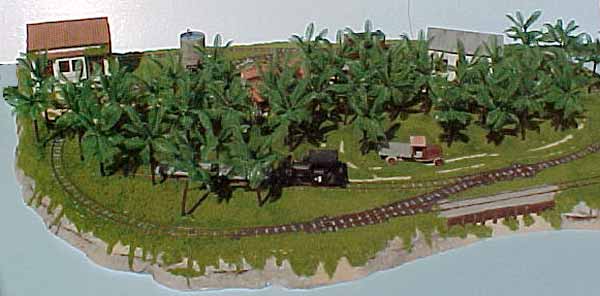
ISLAND 3: “OH, ME FATHER WAS THE KEEPER…”
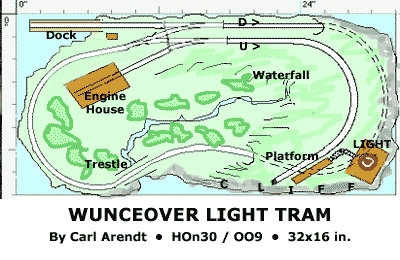

A classic application for an island layout is a tramway hauling supplies and equipment from the dock up the hill to a lighthouse. There were a number of examples of this kind of railway, both in the U.S. and in Europe. Generally the little cars were pushed by hand — but when the hill is as steep as the one at Wunceover, we can be excused for supposing that a light rail “critter” is required! A flat car and a gondola (one-plank wagon) plus a homemade passenger car will complete the roster.
So Wunceover Light Tram features up-the-hill-and-back operations, as well as “fun for visitors” rides that circumnavigate the island. If you want to complicate operations, make a rule that the critter must always be on the downhill end of the one- or two-car train. You’ll find yourself making good use of the concealed oval to run around the train and complete the switching required to get onto the dock!
Wunceover Light Tram is a micro layout, made from a slab of extruded polystyrene insulating foam (either pink or blue) measuring 32×16 inches. There are several good lighthouses available, such as the one from Walthers illustrated here. Grades are steep, but there’s only one or two cars to push up the hill, so you should experience no problems on that score. The layout will be much more effective if you install a flashing rotating beacon light in the tower, with a dolorous foghorn sound periodically groaning from beneath the layout table! Then, if you can figure out a way to create artificial fog to shroud the island…
Thanks go to John Thomas and Bruce Bates whose comments and ideas inspired this piece of lunacy.
Leave a Reply